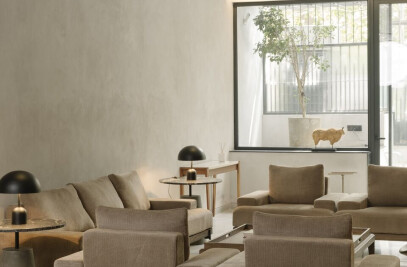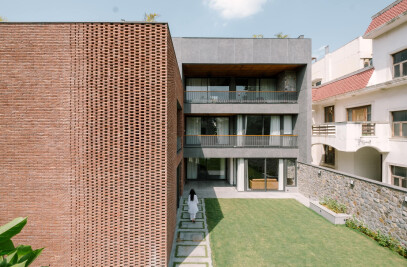In his seminal work, L. Frank Baum uses the yellow brick road as a metaphor for taking the path less known, as the protagonists each seek to find the one thing that eludes them. In the end, the journey itself proves cathartic, exemplifying the values that make the Wizard of Oz such essential reading for children. It is a lesser known fact that the book was written in Chicago, and the yellow brick road was named after winding brunt brick cobblestone roads in Holland, Michigan, where the author used to spend vacations with his family. Much like the novel, this project is a journey of self discovery. As an architectural firm, we are presented with countless opportunities for design, each that come with their own, equally constraining parameters. Rarely though, are we offered two attempts at designing the same project.
The clients approached us in the summer of 2014 to design and build a multi-unit residential building. The land had been in the family for decades and the building on it had outgrown its utility both in terms of spatial configuration and in robustness. The new building would match the prevalent apartment standards of the city, ensuring that it could be either sold or rented as soon as the building was up. Plans were drawn up and sanctioned by the local municipality, but when the cost was estimated, it seemed the project hit a roadblock. The property market in the capital had softened, and no amount of cost-cutting would have made the project viable. We were called in for a drink and shake of hands. That was that.
In 2017, we were called in once more. The client had decided to go ahead with the project, but had one condition. The project had to happen, but he had little time and energy to devote to it and we were the only people he would engage with. It would be up to us to deliver the project on time, in budget and preferably as soon as possible. It seemed straightforward enough since the plans and designs were already approved and the cost was in place as well. However, as we reviewed the plans, it became increasingly obvious that we had evolved in our design sensibilities as a practice. Sustainability had increasingly become a key concern, as had the need to avoid wasteful construction methodologies. The entire building was redesigned, including the structure, services, layout, finishes and the project was submitted for approval. The project broke ground soon after.
The site is located fortuitously near the playground of a large school. The view towards the south and west is filled with tree crowns and the building is oriented to maximise the exposure to that direction. As is typical in Delhi’s plotted development communities, the parcels of land are in the ratio of 2:1, and given the narrow frontage, any internal layout must contend with trying to bring natural light into as many rooms as possible. The four bedrooms are strung on the periphery of the building, organized around a central light shaft that illuminates a family dining area. The living room opens up to the front, shaded from the south sun by a deep balcony. The subterranean level opens up to a sunken courtyard, while also being illuminated by multiple skylights. At the ground level, a walkway leads to the main stair and elevator core, while a driveway on either side leads to car parking at the rear.
The project illustrates our evolving understanding about the durability of materials in our harsh climate. Brick is inherently durable - Clay bricks last almost indefinitely, being largely immune to fire, wind borne debris, and temperature fluctuations and their exceptional thermal mass helps mitigate heat transfer. While the manufacture of bricks is recognized to be energy intensive, over 89% of the GHG impact of a building lies in its operating costs over the 50 year lifecycle of a building. Within those parameters, bricks outperform almost every other building material, effectively reducing the environmental impacts from other systems like air conditioning and heating. Additionally, manufacturing processes have remarkably improved, with the use of energy efficient tunnel kilns, fire dusing natural gas, and all waste heat and clay being recycled within the plant, with the effective energy consumption per brick reducing every year. Conventional red brick is dark and absorbent when seen from the point of view of Delhi’s summer sun. The pale coloured brick eventually selected for the facade is a lighter colour that mitigates heat gain while maintaining longevity.
Every component of the building was selected with the same parameters of high performance and inherent robustness. Aluminum windows with double glazing are used all around, the terrace is insulated and landscaped, the air-conditioning uses variable refrigerant volume based on active monitoring of indoor use, and LED lighting is used throughout the building. Sensors are fitted in the washrooms and the stair, and they automatically control the lights based on movement and ambient light conditions. The apartments are secured with a keyless central security system with digital access.
Just like its namesake, the Yellow Brick House has been a path to self discovery. Free from the specifics of an end-user, the project has been a tool for us to priorities the key elements of architecture - light, space, durability, high-performance and craftsmanship. It has also been a validation of a long held notion that architects will necessarily build better than those with no stake in the design process. By integrating the people who construct our buildings deep into the design thinking of the project, we have achieved better outcomes than in conventional tripartite construction contracts.
The quality of buildings in the post-independent era of India has always been a source of debate, as modernist predilections of design ideals forced the abandonment of traditional craftsmanship in the pursuit of bland simplicity. This project seeks to up-end those ideals, fore-going modernity in the pursuit of sustainability

































